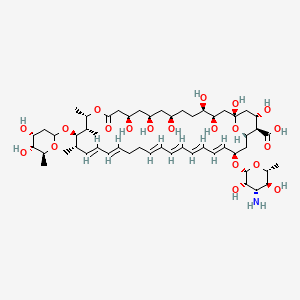| MeSH term | MeSH ID | Detail |
|---|---|---|
| Anemia, Sickle Cell | D000755 | 34 associated lipids |
| Aspergillosis | D001228 | 5 associated lipids |
| Blastomycosis | D001759 | 5 associated lipids |
| Body Weight | D001835 | 333 associated lipids |
| Burns | D002056 | 34 associated lipids |
| Candidiasis, Oral | D002180 | 11 associated lipids |
| Candidiasis, Vulvovaginal | D002181 | 8 associated lipids |
| Cystic Fibrosis | D003550 | 65 associated lipids |
| Dermatomycoses | D003881 | 17 associated lipids |
| Gonorrhea | D006069 | 7 associated lipids |
Nystatin A3
Nystatin A3 is a lipid of Polyketides (PK) class. Nystatin a3 is associated with abnormalities such as Mycoses, Candidiasis of the genitals and Gigantism. The involved functions are known as Drug Interactions, Process, Synthesis, Fermentation and Anabolism. Nystatin a3 often locates in Cell membrane, Membrane, Protoplasm, Entire oral cavity and integral to membrane. The associated genes with Nystatin A3 are Gene Clusters. The related lipids are Sterols, 1,2-oleoylphosphatidylcholine, Membrane Lipids, DOPE and N-caproylsphingosine.
Cross Reference
Introduction
To understand associated biological information of Nystatin A3, we collected biological information of abnormalities, associated pathways, cellular/molecular locations, biological functions, related genes/proteins, lipids and common seen animal/experimental models with organized paragraphs from literatures.
What diseases are associated with Nystatin A3?
Nystatin A3 is suspected in Mycoses, Candidiasis of the genitals, Gigantism and other diseases in descending order of the highest number of associated sentences.
Related references are mostly published in these journals:
| Disease | Cross reference | Weighted score | Related literature |
|---|
Possible diseases from mapped MeSH terms on references
We collected disease MeSH terms mapped to the references associated with Nystatin A3
PubChem Associated disorders and diseases
What pathways are associated with Nystatin A3
There are no associated biomedical information in the current reference collection.
PubChem Biomolecular Interactions and Pathways
Link to PubChem Biomolecular Interactions and PathwaysWhat cellular locations are associated with Nystatin A3?
Visualization in cellular structure
Associated locations are in red color. Not associated locations are in black.
Related references are published most in these journals:
| Location | Cross reference | Weighted score | Related literatures |
|---|
What functions are associated with Nystatin A3?
Related references are published most in these journals:
| Function | Cross reference | Weighted score | Related literatures |
|---|
What lipids are associated with Nystatin A3?
Related references are published most in these journals:
| Lipid concept | Cross reference | Weighted score | Related literatures |
|---|
What genes are associated with Nystatin A3?
Related references are published most in these journals:
| Gene | Cross reference | Weighted score | Related literatures |
|---|
What common seen animal models are associated with Nystatin A3?
There are no associated biomedical information in the current reference collection.
NCBI Entrez Crosslinks
All references with Nystatin A3
Download all related citations| Authors | Title | Published | Journal | PubMed Link |
|---|---|---|---|---|
| Barlow AJ et al. | Chronic paronychia. | 1970 | Br. J. Dermatol. | pmid:4988198 |
| Leech PJ and Bedbrook GM | An australian case of maduromycosis. | 1970 | Aust N Z J Surg | pmid:5266973 |
| Meinhof W | [Treatment of Candida mycoses of skin and mucous membranes]. | 1970 | Dtsch. Med. Wochenschr. | pmid:5310512 |
| Cass A et al. | The ion permeability induced in thin lipid membranes by the polyene antibiotics nystatin and amphotericin B. | 1970 | J. Gen. Physiol. | pmid:5514157 |
| Holz R and Finkelstein A | The water and nonelectrolyte permeability induced in thin lipid membranes by the polyene antibiotics nystatin and amphotericin B. | 1970 | J. Gen. Physiol. | pmid:5514158 |
| Robinson MH et al. | Use of vancomycin, colistimethate, nystatin medium to transport gonococcal specimens. | 1970 | Public Health Rep | pmid:4191775 |
| Ashton H et al. | Therapeutics X. Topical antifungal agents. | 1970 | Br. J. Dermatol. | pmid:5431557 |
| Saloma AE et al. | The intermittent feeding of anti-bacterial and-or antifungal agents to laying hens. | 1970 | Br. Poult. Sci. | pmid:5433120 |
| Abboud IA and Hanna LS | Ocular fungus. Report of two cases. | 1970 | Br J Ophthalmol | pmid:5433351 |
| Krakówka P et al. | Infection of the pleura by Aspergillus fumigatus. | 1970 | Thorax | pmid:5441996 |
| Walker AH | Urinary symptoms caused by gynaecological lesions. | 1970 | Proc. R. Soc. Med. | pmid:5445560 |
| Darrell JH and Garrod LP | Secondary septicaemia from intravenous cannulae. | 1969 | Br Med J | pmid:5771579 |
| Alexander JG | Tetracycline and nystatin. | 1969 | Br Med J | pmid:5780448 |
| Green WR et al. | Asperillosis of the orbit. Report of ten cases and review of the literature. | 1969 | Arch. Ophthalmol. | pmid:5806054 |
| Arthur LJ | Pulmonary candidosis. | 1969 | Proc. R. Soc. Med. | pmid:5823808 |
| Coskey RJ and Paul L | Ampicillin sensitivity in infectious mononucleosis. | 1969 | Arch Dermatol | pmid:4312379 |
| DeVoe AG | Management of chronic corneal ulcers. | 1969 | South. Med. J. | pmid:4899145 |
| Newman DM and Hoog JM | Torulopsis glabrata pyelonephritis. | 1969 | J. Urol. | pmid:5347756 |
| Wegmann T | [Treatment of the lung mycoses]. | 1969 | Dtsch. Med. Wochenschr. | pmid:5352271 |
| Ellison AC et al. | Chemotherapy of experimental keratomycosis. | 1969 | Am. J. Ophthalmol. | pmid:5352600 |
